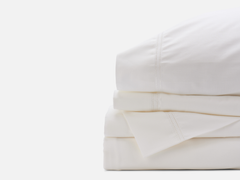Between the different types of mattresses, different materials for sheets, and the different sizes of pillows, there are countless ways to make your bed your own. But when it comes to creating a bed that is warm, comfortable, and looks amazing, your most important choice will be the top layer. And when it comes to choosing that top layer, your toughest choice will be choosing between a quilt and a duvet. The best way to make that choice is by learning a little about each option.
Quilts
When someone talks about a quilt, it brings a lot of pictures to mind. Maybe you picture the quilt from your grandmother’s bed that she made herself. Maybe you imagine the worn quilts you used to have picnics on when you were a child. But aside from warm, hand-stitched memories, what exactly makes a quilt?
What Makes a Quilt
A quilt is different from your average blanket because of its layers. Quilts usually have three layers: the backing, the front, and the batting. The backing is usually a simple pattern that serves as the foundation of the rest of the quilt. The front is where the colorful patches and the stitched patterns go. This is usually the part people envision when they think of quilts. Our quilts feature a diamond pattern on both the front and the back so it is reversible and timeless. In the center of both layers is the batting. Our batting is made from 100% Red Land Cotton grown on our family farm. It’s lightweight, yet warm!
Reasons To Choose a Quilt
Lightweight and Cool
Wrapping up in a quilt is like wrapping up in the embrace of an old friend—it lies close to the body yet doesn’t smother you. This makes it the perfect bedding choice for the summertime, especially for people who need tips to stay cool while sleeping. It’s also a great option for the household that cranks its thermostat just a little too high in the winter or for those who naturally get hot in their sleep.
Perfect for Layering
Layers create a lot of visual interest when you look at a bed. They allow you to add different colors and patterns that you can mix and match at different times of the year. Not only that, but layers on a bed will keep you warmer when you sleep while still allowing the option of quickly cooling down if you get too warm in the middle of the night. Because quilts are usually nice and thin, they are the perfect choice for layered bedding.
Down-Home Look
Quilts usually have a lot more going on visually as far as colors and patterns go, and they are essential if you want to pull off a farmhouse style in your room. Not to mention that quilts carry emotional weight, as we briefly mentioned above. They call to mind our childhoods, our families, and, in many ways, our heritage. Because of that, the sight of a quilt can give you a feeling of homecoming more than most other items you might have in your room. We know our American-made quilts can add some cozy décor to any home.
Duvets
Some people prefer to harken back to a little cottage in the European countryside when they go to make their bed, and for that, you can look no further than a duvet. However, even though duvets and quilts tend to paint different pictures in your mind, they’re kissing cousins when you get down to it with just a few key differences between them.
What Makes a Duvet
Like quilts, duvets have three different layers: the back, front, and batting. Duvet backs and fronts usually don’t have the same colorful, patchwork look to them that quilts have (though ours do). But the duvet itself usually comes tucked in a duvet cover, which may come in different colors or with designs stitched in it. But the real difference between duvets and quilts is the middle layer. Duvets are usually filled with down, feathers, or wool, giving them a more pillowy look than quilts.
Reasons To Choose a Duvet
It’s Warmer
Because there is a lot more “stuff” inside a duvet, they tend to be a little warmer than quilts. And even though they don’t often lend themselves to a layered look, you can still slip blankets underneath them to make duvets even warmer. However, if you want to hold onto your duvet in the summer, you can find lighter-weight duvets and drop the bottom layers. Or you can use your duvet’s cover for your bedding and store the duvet itself away until winter.
There’s More Weight
For some people, being trapped under too much weight while trying to sleep can feel like a nightmare. For others, extra weight is soothing, helping them relieve anxiety and drift off to sleep the same way being swaddled helps babies nod off. Duvets tend to have more weight to them than the average quilt. If you’re a restless sleeper who doesn’t mind a little extra weight, a duvet may be the cure to your sleepless woes.
Easily Changeable Look
The reason duvets usually come with covers is to keep them from getting too dirty, so you can avoid a trip to the cleaners. However, duvet covers also exist to spruce up the look of a duvet. They come in a variety of colors and patterns that you can switch out with ease when you want to change up your room’s look without having to buy a whole new duvet. Plus, duvet covers can make changing out bedding for your children easier, too; you won’t have to wash an entire quilt.
Making the Choice
So, we’ve come back to the big question of quilt vs. duvet. Which to choose ultimately depends on two things: your sleeping habits and your preferred style. Those who like to stay cool or prefer having layers when they sleep should lean more toward a quilt. Those who want a warmer, heavier covering should opt for a duvet. As far as style goes, the best thing to do is take a look at your room and decide if a flatter quilt that lays close to the bed look is better for your room or if your space better suits the pillowy look of a duvet.
But if you’re looking for a classic, down-home look, Red Land Cotton offers both duvet covers and quilts to tie your room together and help you slip into a comfortable night’s sleep.








